Genus Crematogaster - Subgenus Atopogyne
| The Ants of
Africa Genus Crematogaster - Subgenus Atopogyne |
|
| Genus Crematogaster Introduction |
Diagnostic Features Antennae 11-jointed. Frontal carinae well developed. Promesonotal suture impressed, metanotum carinate in front. Propodeal spines often curved downwards. Petiole broadened in front, usually oval or at least rounded at the anterior angles. Postpetiole impressed behind.
Forel (1911d) erected the subgenus to separate depressa and julienni, together with the European species he described as hellenica (Forel, 1911d: 342; type location Greece; now regarded as a subspecies of Crematogaster (Atopogyne) lorteti Forel, 1910e: 435, type location Syria). His definition was - Subgenus, characterised by the depressed head, being rectangular or trapezoidal; with straight mandibles, with a long terminal border, and elongated thorax, narrowed anteriorly; specially so in the female. On hellenica, he noted that it was easily distinguished from jullieni by the head being smooth (except anteriorly) and from depressa by its shorter mandibles with the entire terminal border with teeth.
Bernard (1952) noted the subgenus members as generally large and
striated, the most common of the genus and the greatest nuisances in
plantations; 21 species were known from Africa.
The true Atopogyne appear to be polymorphic and to have large colonies based on big carton nests.
Key to workers from Africa - some sections of are left as visual
groupings rather than fully dichotomous separations. As far as possible
the images are of major workers.
| 1 |
Petiole with small but
distinct anterior, subventral tooth; propodeal spines long and splayed
out in dorsal view |
2 |
| -- | Petiole without a subventral tooth |
3 |
| 2 | 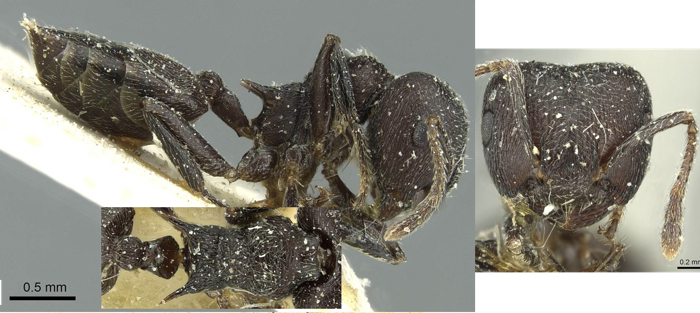 TL 3.2-4.0 mm; mandibles
with four teeth; strongly sculptured with dense reticulation underlying
strong striation; colour black, appendages brown; matt; dense short
pilosity and overall pubescence TL 3.2-4.0 mm; mandibles
with four teeth; strongly sculptured with dense reticulation underlying
strong striation; colour black, appendages brown; matt; dense short
pilosity and overall pubescence |
Congo Basin - ambigua |
| -- |  TL ca 4.0 mm; dirty yellow; with no more than very fine
sculpturation TL ca 4.0 mm; dirty yellow; with no more than very fine
sculpturation |
Congo Basin - tibialis |
| 3 |
Bicoloured, at least part orange or orange-yellow | 4 |
| -- | Unicoloured, brown to black | 5 |
| 4 |  Body brown, gaster
orange; TL 3.7-6.4 mm; major head much wider than long, CI 118, SI 47 Body brown, gaster
orange; TL 3.7-6.4 mm; major head much wider than long, CI 118, SI 47 |
West Africa & Congo Basin - clariventris |
| -- | 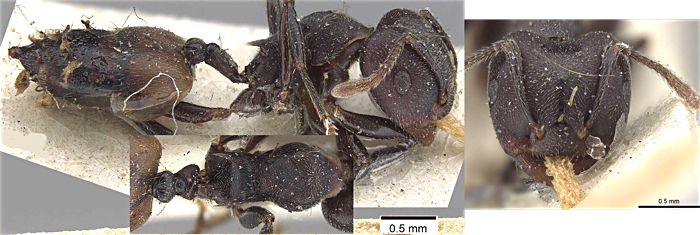 Smaller
TL 3.2-5 mm; colour like clariventris, generally blackish but
with gaster somewhat darker (red-brown?); mesonotum with carina
projecting forward less than clariventris; petiole narrow and
scarcely wider anteriorly Smaller
TL 3.2-5 mm; colour like clariventris, generally blackish but
with gaster somewhat darker (red-brown?); mesonotum with carina
projecting forward less than clariventris; petiole narrow and
scarcely wider anteriorly |
Cameroun & Zaïre - biimpressa |
| -- |  TL 4.3-4.7 mm; head
distinctly wider
than long; pronotum from above regularly rounded; mesonotum higher than
pronotum with promesontal suture distinct; propodeal dorsum only
two-fifths the length of the declivity; head and alitrunk
yellowish-red-brown; gaster brown-black with base lighter TL 4.3-4.7 mm; head
distinctly wider
than long; pronotum from above regularly rounded; mesonotum higher than
pronotum with promesontal suture distinct; propodeal dorsum only
two-fifths the length of the declivity; head and alitrunk
yellowish-red-brown; gaster brown-black with base lighter |
South Africa - resulcata |
| -- | 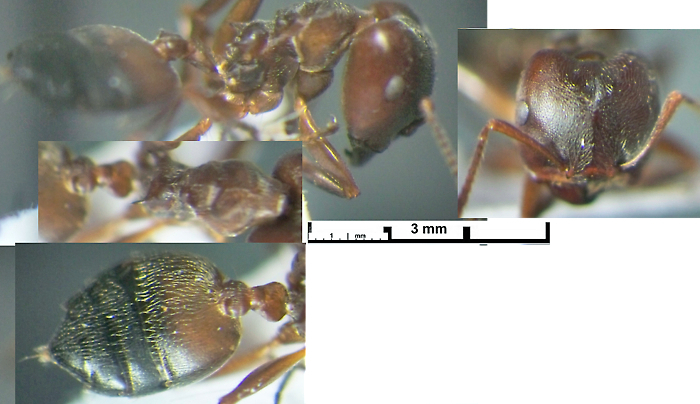 Larger, major TL 6.5
mm plus; colour generally
red-brown (chestnut) but
with posterior two-thirds of gaster much darker; distinguished by a
lack
of erect hairs and very fine almost unnoticeable pubescence Larger, major TL 6.5
mm plus; colour generally
red-brown (chestnut) but
with posterior two-thirds of gaster much darker; distinguished by a
lack
of erect hairs and very fine almost unnoticeable pubescence |
Liberia - new species Liberia |
| . | Essentially unicolorous | . |
| 5 |
Propodeal spines no more than sharp denticles, metanotal groove weak | 6 |
| -- | Propodeal spines distinct and set at top of declivity; metanotal groove quite deeply impressed | 7 |
| 6 |  TL 3.5-5.6 mm; dark
chestnut brown (species A? but this seems monomorphic) TL 3.5-5.6 mm; dark
chestnut brown (species A? but this seems monomorphic) |
West Africa & Central African Republic - mottazi |
| -- | 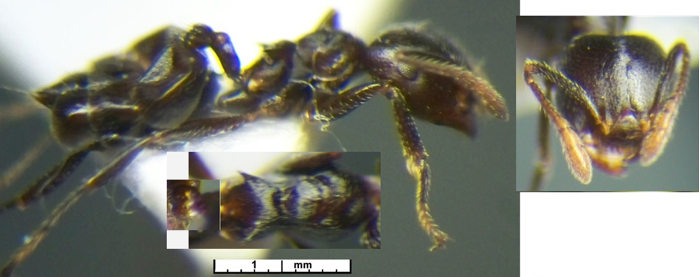 TL 2.5-3 mm, head with sides and occiput rounded, the
latter weakly so; (possibly minors only, but not
stated, note species A also seems monomorphic); blackish, extremities
brownish, tarsi and mandibles apically reddish TL 2.5-3 mm, head with sides and occiput rounded, the
latter weakly so; (possibly minors only, but not
stated, note species A also seems monomorphic); blackish, extremities
brownish, tarsi and mandibles apically reddish |
Zaïre & Gabon - kasaiensis |
| -- | 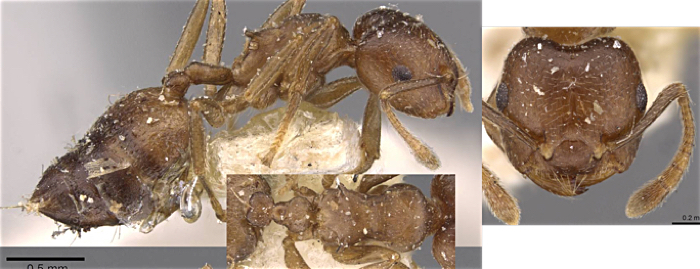 TL 3.3-3.7 mm; orange
brown TL 3.3-3.7 mm; orange
brown |
Cameroun & Zaïre - biemarginata |
| -- | 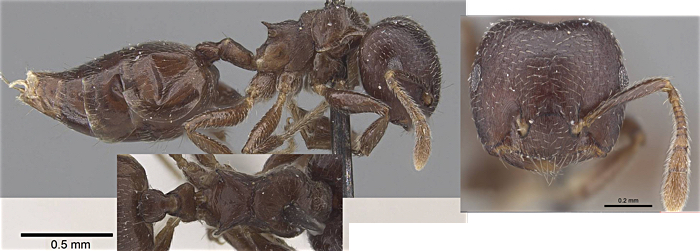 TL 2.5-3 mm (possibly minors only, but not
stated); head, alitrunk and gaster
brownish, tarsi and funiculi yellowish TL 2.5-3 mm (possibly minors only, but not
stated); head, alitrunk and gaster
brownish, tarsi and funiculi yellowish |
Cameroun & Zaïre - variegata |
| . | Propodeal spines distinct and set at top of declivity; metanotal groove quite deeply impressed | . |
| 7 |
 Propodeal
spines with prominent raised spiracle at base (with distinct margin);
the spines usually fairly short and distinctly downturned (long in one
species) Propodeal
spines with prominent raised spiracle at base (with distinct margin);
the spines usually fairly short and distinctly downturned (long in one
species) |
buchneri group - 8 |
| -- | 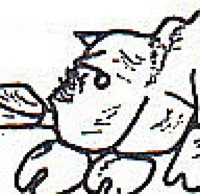 Propodeal
spines moderately long and not downturned; spiracle not raised Propodeal
spines moderately long and not downturned; spiracle not raised |
depressa group - 15 |
| - | -- | |
| 8 |
Head longer than wide | africana-group - 9 |
| -- | Head at least as wide as long | 10 |
| 9 | 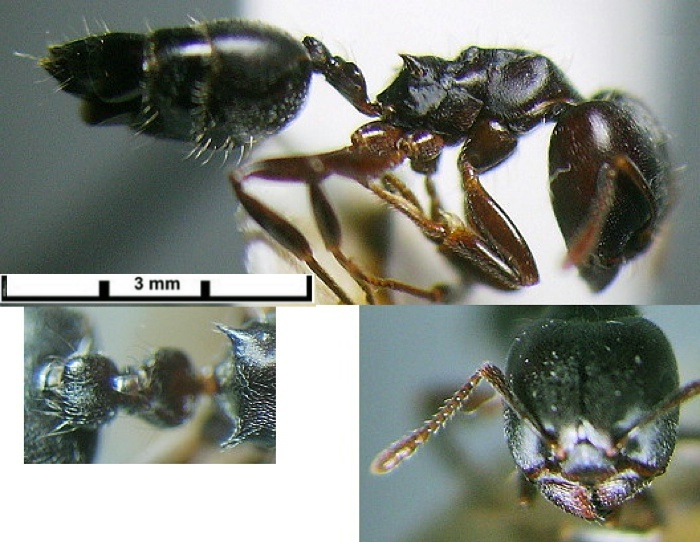 TL 3.25-5.5 mm;
propodeal spiracle prominently raised; matt, dull
dark brown-black; numerous erect hairs TL 3.25-5.5 mm;
propodeal spiracle prominently raised; matt, dull
dark brown-black; numerous erect hairs |
West Africa & Congo Basin - africana |
| -- |  TL 2.8-4.6 mm; uniform red-brown TL 2.8-4.6 mm; uniform red-brown |
Cameroun & Zaire - winkleri |
| -- |  Large TL to 7.5 mm; reddish-brown, with reddish
appendages; matt and finely sculptured Large TL to 7.5 mm; reddish-brown, with reddish
appendages; matt and finely sculptured |
Cameroun - batesi |
| -- |  TL 3.5-5.8 mm; uniform dull yellow-brown; TL 3.5-5.8 mm; uniform dull yellow-brown; |
Congo - adultera |
 |
buchneri group | -- |
| 10 |  Head wider than long; TL
up to 6.5 mm; mesonotum with high central carina; propodeal spiracle
lower; colour reddish-brown, appendages darker; silky gloss appearance;
sparse yellowish decumbent hairs Head wider than long; TL
up to 6.5 mm; mesonotum with high central carina; propodeal spiracle
lower; colour reddish-brown, appendages darker; silky gloss appearance;
sparse yellowish decumbent hairs |
West Africa
& Congo Basin - buchneri |
| -- | Head square or nearly so | 11 |
| 11 |  TL no more than 2.6 mm;
lightly sculptured; shiny black TL no more than 2.6 mm;
lightly sculptured; shiny blackProbably not an Atopogyne |
Zaïre (? Nigeria & Guinea) - laurenti |
| -- | TL of smallest > 2.6 mm | 12 |
| 12 |  TL 2.8-3.5 mm;
head square with rounded posterior corners, sides convex, widest at
level of eyes, in lateral view distinctly flattened; head with dense
fine striations, also on pronotum dorsum, rest of alitrunk and petiole
finely rugo-reticulate; dark chestnut brown; overall with fine
yellowish pubescence and quite numerous long erect hairs TL 2.8-3.5 mm;
head square with rounded posterior corners, sides convex, widest at
level of eyes, in lateral view distinctly flattened; head with dense
fine striations, also on pronotum dorsum, rest of alitrunk and petiole
finely rugo-reticulate; dark chestnut brown; overall with fine
yellowish pubescence and quite numerous long erect hairs |
West Africa & Congo Basin - wasmanni |
| -- | TL of smallest at least 3.2 mm | 13 |
| 14 |  TL 3.4-3.7 mm; less shiny;
propodeal spines longer (than laurenti) - close in size and
form to the media 2 worker of depressa
- below TL 3.4-3.7 mm; less shiny;
propodeal spines longer (than laurenti) - close in size and
form to the media 2 worker of depressa
- below |
Zaïre - theta |
 |
depressa group | -- |
| 15 | Propodeal spines short | 16 |
| -- | Propodeal spines at least as long as width between bases | 17 |
| 16 |  TL 3.4-7.3 mm;
mandible of largest with reduced teeth; head near square with fairly
straight posterior margin; dark brown-black; dense pilosity TL 3.4-7.3 mm;
mandible of largest with reduced teeth; head near square with fairly
straight posterior margin; dark brown-black; dense pilosity |
West Africa & Congo Basin - depressa |
| -- |  TL 3.2-5.5 mm; mandible
with five teeth; short propodeal
spines; short petiole; head and alitrunk with dense fine striations;
colour black, apical areas rust; quite abundant long greyish hairs TL 3.2-5.5 mm; mandible
with five teeth; short propodeal
spines; short petiole; head and alitrunk with dense fine striations;
colour black, apical areas rust; quite abundant long greyish hairs |
West Africa & Congo Basin - jullieni |
| 17 |  TL 2.5-2.7 mm; propodeal
spines as long as basal width and sharp; very black, shiny, almost no
erect hairs and little pubescence TL 2.5-2.7 mm; propodeal
spines as long as basal width and sharp; very black, shiny, almost no
erect hairs and little pubescence |
West Africa & Congo Basin - kohli |
| -- | Sculpturation of fine striations, not shiny | 18 |
| 18 | 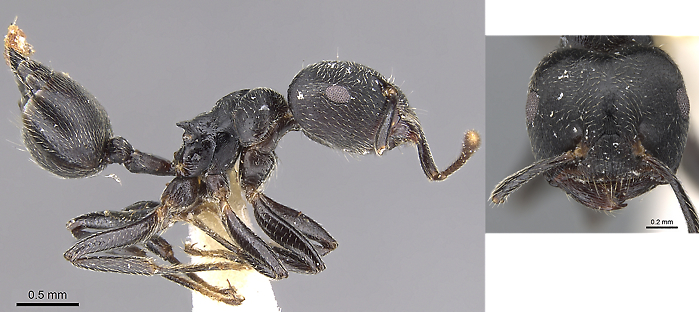 TL 3-4 mm; head slightly
longer than wide; colour black, antennal club and tarsi dirty-yellow;
short yellow decumbent hairs and some longer erect yellow hairs -
almost certainly a minima worker of C. depressa TL 3-4 mm; head slightly
longer than wide; colour black, antennal club and tarsi dirty-yellow;
short yellow decumbent hairs and some longer erect yellow hairs -
almost certainly a minima worker of C. depressa |
Togo - togoensis |
| -- | 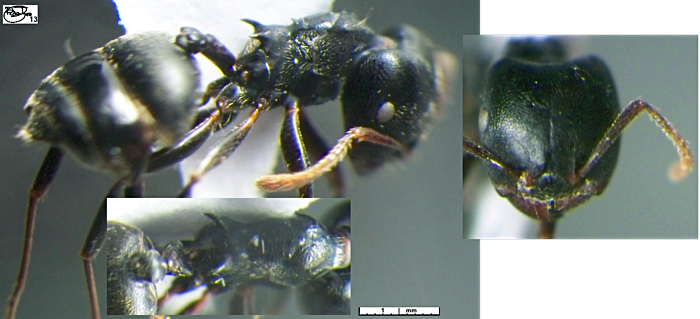 TL ca 5.5 mm - 3.0
mm; fine
striate sculpturation; colour black with yellowish extremities, dark
orange mandibles quite distinctive;
yellowish pilosity (type damaged) TL ca 5.5 mm - 3.0
mm; fine
striate sculpturation; colour black with yellowish extremities, dark
orange mandibles quite distinctive;
yellowish pilosity (type damaged) |
West Africa - cuvierae |
| MYRMICINAE Introduction |
© 2007, 2008, 2009, 2013, 2014, 2015, 2016, 2017, 2018 - Brian
Taylor
CBiol
FRSB FRES 11, Grazingfield, Wilford, Nottingham, NG11 7FN, U.K. |
href="atopogyne.htm"